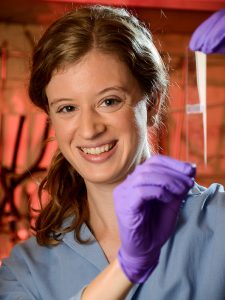Graduate students earn GEAB Impact Awards for creating new knowledge to help N.C. industry, communities and citizens

Graduate student strengthens N.C. manufacturing
Today, manufacturing drives 19 percent of North Carolina’s gross domestic product and employs more than 338,000 workers. The state is ranked ninth nationally in total manufacturing employment and first in the southeastern United States. Industries have pursued technologies that minimize the energy and resources necessary to make products in order to lower costs and fulfill consumer demand for greener manufacturing.
Doctoral student Sara Turner (pictured right) has developed a type of adhesive that could aid tremendously in automated production processes: a reusable material capable of de-bonding (un-gluing) and re-bonding (re-gluing) on demand in response to applied heat. This adhesive allows for remote repair of complex structural components in bonded parts by simple heating, and in the disassembly of bonded components at the end of their lifetime during recycling. The material, composed of “spaghetti-like” polymer molecules, also maintains its original strength after multiple de-bonding and re-bonding cycles. The design and implementation of robust new technologies such as Turner’s adhesive will ensure that North Carolina is a top player in the green manufacturing industry.
“Sara’s results are an important advance in the field of dynamic adhesives and represent a step forward for manufacturing processes,” says Valerie Ashby, chemistry professor and Turner’s adviser.
Meet all 26 recipients of the 2015 Graduate Education Advancement Board Impact Awards


